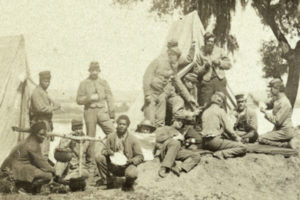During the Civil War, with practically every fit white man serving in the Confederate Army, South Carolina had a serious shortage of conventional labor.
So, since most of the population consisted of enslaved African-Americans, that’s where the state turned for workers to build such military structures as fortifications and breastworks, as well as to manufacture goods needed in the war effort.
As slaves, they were pressed into service and not compensated. But then, six decades later, the South Carolina General Assembly decided to pay tiny pensions to those whose labor had supported the Confederate war effort.
On Friday, July 26, at the South Carolina Confederate Relic Room and Military Museum in Columbia, Alexia Jones Helsley will speak about the findings in her book, South Carolina’s African American Confederate Pensioners, 1923-1925, which was published by the S.C. Department of Archives and History in 1998.
Helsley, a senior instructor in history at the University of South Carolina-Aiken, says that generally speaking, “pensions were a form of poor relief.” For example, for service in the Revolutionary War, you initially “had to prove you had little or no income.” That was probably the context in which these pensions were created.
In 1923, the S.C. Legislature initiated the program that specifically created pensions for African-Americans who had served in support roles during the Civil War. There were so many takers that in 1924, the program was scaled back. No longer would pensions go to those involved in construction and manufacturing. The payments were limited to those who had served “in the camps,” as cooks, laundry personnel and body servants to whites in active service.
No one got rich off these pensions, which amounted to no more than about $25 a year. And eligibility was sometimes determined on the basis of arbitrary considerations. For instance, a letter might say that “So-and-so deserves a pension because he’s a good Democrat.” These determinations were often made on the local level rather than by the state.
History is full of anomalies, Helsley notes. She found that four African-Americans received pensions as early as 1887, long before the state plan was instituted. And in one case, a black woman applied for a pension as the widow of a white man who served in the S.C. cavalry.
And to address a topic that has engendered much controversy in recent years, “Some claimed that they were actual soldiers” but documenting their service is difficult.
Helsley is currently senior instructor of history and university archivist at USC-Aiken. She is a longtime student of South Carolina’s rich and diverse history. A magna cum laude graduate of Furman University, she earned her master’s in history at the University of South Carolina. Before joining USC-Aiken, she worked as an archivist for the South Carolina Department of Archives and History.
The free noon lecture on the 26th is part of the museum’s monthly Lunch and Learn series, and is open to the public.
About the South Carolina Confederate Relic Room and Military Museum
Founded in 1896, the South Carolina Confederate Relic Room and Military Museum is an accredited museum focusing on South Carolina’s distinguished martial tradition through the Revolutionary War, Mexican War, Civil War, Spanish-American War, World Wars I and II, Vietnam, the War on Terror, and other American conflicts. It serves as the state’s military history museum by collecting, preserving, and exhibiting South Carolina’s military heritage from the colonial era to the present, and by providing superior educational experiences and programming. It is located at 301 Gervais St. in Columbia, sharing the Columbia Mills building with the State Museum. For more information, go to https://crr.sc.gov/.



